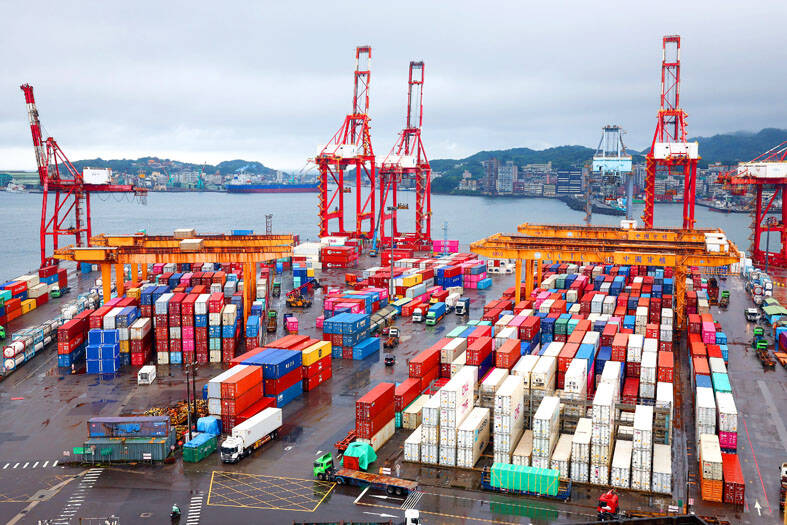Taiwan’s economy is expected to grow 4.45 percent this year, up from a 3.1 percent forecast in May, as stronger-than-expected exports and private investment offset global trade headwinds, the Directorate-General of Budget, Accounting and Statistics (DGBAS) said yesterday.
“While US trade policy changes continue to disrupt global commerce, robust demand for artificial intelligence [AI] and emerging technology applications is fueling expansion,” DGBAS Minister Chen Shu-tzu (陳淑姿) told a news conference in Taipei.
Global AI data center construction has remained sturdy despite the emergence of China’s low-cost DeepSeek platform, Chen said, adding that Washington’s recent relaxation of restrictions on chip sales to China has also sped up deliveries of advanced semiconductors and information and communications technology (ICT) products.

Photo: CNA
Electronic components and ICT goods now account for more than 70 percent of Taiwan’s exports, she said.
Second-quarter GDP rose 8.01 percent from a year earlier, slightly above a 7.96 percent estimate last month, after exports in US dollar terms surged 34.06 percent. Full-year exports are expected to reach a record US$589.2 billion, up 24 percent from last year, driven by the ongoing AI boom, the official said.
The DGBAS now projects GDP growth of 2.91 percent in the current quarter and 1.72 percent in the fourth quarter, a noted improvement from the near-zero outlook in May.
The impact of the US tariffs should be manageable, as major Taiwanese firms have built manufacturing facilities in the US and other tariff-friendly markets to cushion the blows of US tariffs and potential semiconductor duties, Chen said.
On the domestic front, private consumption in the second quarter rose 0.49 percent, contributing 0.22 percentage points to GDP growth. However, gains in food, entertainment and transport spending were partly offset by weaker car sales and a drop in stock market turnover, the official said.
Private investment, another bright spot, rose on capacity expansions in advanced manufacturing and the rollout of new production lines for semiconductors, electric vehicles and renewable energy, the DGBAS said.
As a result, first-half GDP expanded 6.75 percent and is forecast to increase 2.3 percent in the second half.
The consumer price index is expected to rise 1.76 percent this year, slowing from last year’s pace and back within the central bank’s 2 percent target, giving room for maintaining a neutral monetary stance.
Risks to the outlook include the scale of US tariffs, the speed of AI and high-performance computing adoption, domestic policy responses, geopolitical tensions, and global monetary policy shifts, Chen said.
The DGBAS forecasts GDP growth of 2.81 percent next year, as the effects of tariffs and front-loading fade.
While the IMF expects global trade growth to slow to 1.9 percent next year, Taiwan’s exports are seen rising 2.19 percent to another record of US$602.1 billion, buoyed by sustained AI-related demand from global technology companies and governments building AI infrastructure, the DGBAS said.

GROWING OWINGS: While Luxembourg and China swapped the top three spots, the US continued to be the largest exposure for Taiwan for the 41st consecutive quarter The US remained the largest debtor nation to Taiwan’s banking sector for the 41st consecutive quarter at the end of September, after local banks’ exposure to the US market rose more than 2 percent from three months earlier, the central bank said. Exposure to the US increased to US$198.896 billion, up US$4.026 billion, or 2.07 percent, from US$194.87 billion in the previous quarter, data released by the central bank showed on Friday. Of the increase, about US$1.4 billion came from banks’ investments in securitized products and interbank loans in the US, while another US$2.6 billion stemmed from trust assets, including mutual funds,

Micron Memory Taiwan Co (台灣美光), a subsidiary of US memorychip maker Micron Technology Inc, has been granted a NT$4.7 billion (US$149.5 million) subsidy under the Ministry of Economic Affairs A+ Corporate Innovation and R&D Enhancement program, the ministry said yesterday. The US memorychip maker’s program aims to back the development of high-performance and high-bandwidth memory chips with a total budget of NT$11.75 billion, the ministry said. Aside from the government funding, Micron is to inject the remaining investment of NT$7.06 billion as the company applied to participate the government’s Global Innovation Partnership Program to deepen technology cooperation, a ministry official told the

Taiwan Semiconductor Manufacturing Co (TSMC, 台積電), the world’s leading advanced chipmaker, officially began volume production of its 2-nanometer chips in the fourth quarter of this year, according to a recent update on the company’s Web site. The low-key announcement confirms that TSMC, the go-to chipmaker for artificial intelligence (AI) hardware providers Nvidia Corp and iPhone maker Apple Inc, met its original roadmap for the next-generation technology. Production is currently centered at Fab 22 in Kaohsiung, utilizing the company’s first-generation nanosheet transistor technology. The new architecture achieves “full-node strides in performance and power consumption,” TSMC said. The company described the 2nm process as

Even as the US is embarked on a bitter rivalry with China over the deployment of artificial intelligence (AI), Chinese technology is quietly making inroads into the US market. Despite considerable geopolitical tensions, Chinese open-source AI models are winning over a growing number of programmers and companies in the US. These are different from the closed generative AI models that have become household names — ChatGPT-maker OpenAI or Google’s Gemini — whose inner workings are fiercely protected. In contrast, “open” models offered by many Chinese rivals, from Alibaba (阿里巴巴) to DeepSeek (深度求索), allow programmers to customize parts of the software to suit their